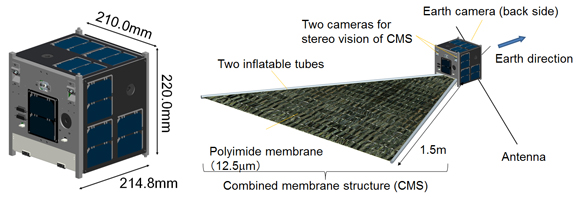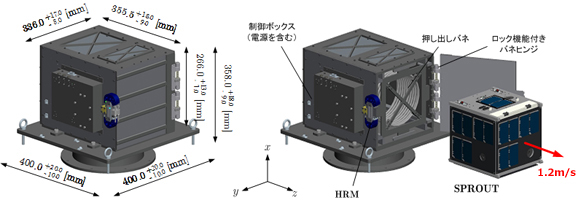SPROUT
 SPROUT(Space Research on Unique Technology) is the third satellite of our laboratory that is 20cm cube (8U) satellite with 7.1kg weight. The mission of SPROUT is space verification of combined membrane structure. SPROUT aims for the evaluation of the influence of the combined membrane structure on the attitude motion of the satellite by considering the camera image data on orbit, several sensor data, and the status of the satellite communication. The detail of SPROUT is described in the web site of SPROUT. Check it out!
SPROUT(Space Research on Unique Technology) is the third satellite of our laboratory that is 20cm cube (8U) satellite with 7.1kg weight. The mission of SPROUT is space verification of combined membrane structure. SPROUT aims for the evaluation of the influence of the combined membrane structure on the attitude motion of the satellite by considering the camera image data on orbit, several sensor data, and the status of the satellite communication. The detail of SPROUT is described in the web site of SPROUT. Check it out!
Out laboratory has been researching on deployable structure. We considerd to define the mission of our fitrst satellite SEEDS as the space verification of an inflatable tube at the start of the development of SEEDS, i.e. in 2001. But the mission of SEEDS was changed because we thought we should get the skill of the development of the bus system of nano-satellite before the space verification of depoyable structure. After 13 years, SPROUT was launched.
| Size, Mass | 210.0x214.8x220.0, 7.1kg |
| Project kick off | May 2008 |
| BBM#1 | summer 2008 (Open Class CanSat experiment in ARLISS) |
| Launch opportunity | March 2012 (piggy back on H-IIA) |
| PDR | May 26, 2012 |
| BBM#2 | June 2012 |
| Safty review Phase0/I | Aughst 8, 2012 |
| EM | May 2013 |
| CDR | May 4, 2013 |
| Fit check | Aughst 26, 2013 |
| Safety review PhaseII | September 26, 2013 |
| Safety review PhaseIII | March 19, 2014 |
| FM complete | March 31, 2014 |
| Launch compatibility review | April 2, 2014 |
| Delivary | April 9, 2014 |
| Launch date | 12:05:14 May 24, 2014 (JST+9) |
| Launch vehicle | H-IIA-24 (MHI, JAXA) |
| Launch site | Tanegashima Space Center |
| Launch configuration | Primary satellite : ALOS-2, Piggy back satellite: SPROUT, RIGING-2, SOCRATES, UNIFORM-1 |
| Satellite separation system | N-POD (Nihon University) |
| Launch result | Success. Orbit: SSO, Inclination: 97.9 deg. Appogee:643km, Perigee: 593km |
| 周波数 |
| Downlink (CW) | :437.525MHz |
| Downlink (FM) | :437.525MHz (and 437.600MHz for redunadncy) |
| Downlink (SSTV, Digi-talker) | :437.600MHz |
| Uplink (FM) | : 140MHz band |
| Voice/Message Box Uplink | : 140MHz band |
| Voice/Message Box Downlink | : 437.600MHz |
| My camera Uplink | : 140MHz band |
| My camera Downlink | : 437.600MHz |
|
| Budget | budget supplied by our university, and Grant by MEXT |
SPROUT has two cameras for stereo vision of membrane, one camera for earth photo, and an attitude determination and control system using gyros, sun sensors, a geo-magnetic sensor, geo-magnetic torquers. It has a digi-talker, digi-peater, and SSTV system for amateur radio mission. The mission of SPROUT is classified into the engineering mission and the outreach mission as follows:


| Engineering mission |
| 1) | Demonstration of deployment of combined membrane strucrure |
| 2) | Verification of design method of combined membrane structure |
| 3) | Demonstration of attitude determination and control for several kg class nano-satellite |
| 4) | Prediction of change of orbit altitude decending ratio by combined membrane structure |
| Outreach mission |
| 1) | Satellite operation (camera shoot) by amateur radio people |
| 2) | Regional exchange activities |
| 3) | Service of camera images and information about project activities |
|
In the SPROUT project, we developed a satellite separation system as well as the satellite. The separation method is so-called "Jack-in-the-box" method. As in the right figure, the satellite in the box is pushed out from the box by the spring after the top door of the box is opened. The name of this system is "N-POD&. N-POD opens the door by the hold-release mechanism with wire heat-cut system, and push out the satellite by the spring. In the right figure, the x axis directs toward the axis of the rocket, so that the satellite is pushed out toward the normal of the rocket axis. The development of the satellite separation system was the first time for our laboratory, which was a long way for us.
|
SPROUT is a pigy back satellite of Japanese H-IIA rocket. We took the safty review by JAXA, and improved the engineering model (EM) to a certain level, and developed the flight model (FM) employing the know-how got during the development of EM. We learned the method of the vibration test, shock test, thermal-vacuum test, and the data processing during the development, which was quite valuable for our laboratory. We will use this experience effectively in the next satellite development.
SPROUT was launched in May 24, 2014 successfully. We conducted the attitude determination and control mission from 2014 to 2016, and the deployment mission of the combined menbrane structure in 23 June 2015. The result of the attitude control mission is shown in the web site of Yamazaki Group. You can see the result of the deployment mission at the other web page.
|
|
|

Development scene
|
|




 SPROUT(
SPROUT(